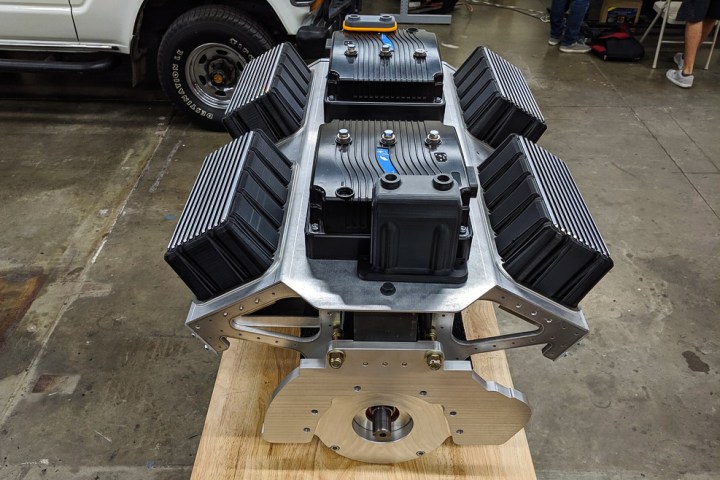
LS swaps are so hot right now. Name a car, and you’re a two-second Google search away from finding images of the ubiquitous Chevy V8 shoved into an unsuspecting chassis. Any car you’re thinking about, it has already been done.
I appreciate the desire that leads one to swap motors in their vehicle. While huge horsepower gains are often the stated goal, the much larger elephant in the room is reliability. You can tune, tweak, and improve a lot of engines to at least 500 horsepower, but you generally introduce one vulnerability for every one horsepower you eke out. LS swapping gives you power for sure, but also a reliability that is hard to match.
But if what you really want is reliability, you can forget the 14,375-odd parts of a modern V8 engine, half of which either rotate or are under immense pressure from caustic chemicals. No Siree, you don’t want an engine at all. If you want a reliable horsepower upgrade for your jalopy, what you want is an electric powertrain with a single moving part.
“But Adam,” I can hear you saying, “I don’t have a crashed Tesla to steal an EV motor from!” First of all, lower your voice. There’s no need to yell here. Secondly, the magic of capitalism means that there is now an enterprising business that has stepped up to fill this very niche!
Electric GT has developed the world’s first electric crate motor to drop into any project car you might have. Whereas typical back-yard electric conversions entail scrounging up an electric motor, all the necessary control modules, and battery packs from some wrecked car or radio-shacking them together yourself, grabbing a conversion from Electric GT vastly simplifies the process for you.

Simply call up Electric GT, place an order for their V8-configured e-Crate Motor, and you’ll receive the motor, control modules, relays, computer systems, and sensors (all built into one compact unit) as well as a vehicle-appropriate number of lithium-ion battery cells. The battery capacity matters if you trying to motivate a small Italian roadster versus a heavy Toyota off-roader – both of which Electric GT has options for.
And that’s it -– you’ve got yourself a “V8” that will bolt up to your existing transmission and you could be running down the road within a number of hours instead of days. Since this electric crate motor could revolutionize car collecting, modifying, and even maintenance options, I wanted to get my hands on it personally and talk to the mad geniuses behind this world first.
Available now is the GTE-240 Crate powerplant with 240 horsepower, while a 255hp version (the GTE-350) is currently under development and taking deposits. If you ordered a 240 today, you could expect to receive it in about 2 months or less.

The workshop itself is an unassuming building (like most evil scientist lairs) about 20 minutes north of Los Angeles. Inside is buzzing with the activity of CAD modelers, electrical engineers, and a few customers who come and go while checking on their cars. The excitement and happiness are palpable inside the Electric GT garage.
In person, the form-factor of the entire “V8” setup with all the modules and computers certainly looks smaller than a traditional engine, but that may be because it looks so clean without hoses, wires, and accessories like a starter motor hanging off it. CNC’d aluminum and 3D printed parts abound on the e-Crate. The whole package is well executed and would be a handsome addition to just about any engine bay.
3D printing is also abundant in GT Electric’s R&D process, with plastic versions of their motors shoved into all sorts of engine bays while they work on new designs or mock-up transmission adaptors. Currently being designed is an adapter for a classic Toyota FJ40 Land Cruiser. You can see here the larger GTE-350 motor mock hooked up to a rebuilt stock transmission. This setup should provide some excellent rock-crawling capability for its owner once completed.

The breadth of vehicles in the GT Electric workshop is astounding, from Porsches to Fiats, BMWs, a couple of generations of Land Cruiser, and even a secret car that the team refused to uncover for me. It is clear that we will be seeing a plethora of e-swaps in 2020.
The few frame-off restorations the company tackles themselves all look properly done and well designed. At the time of our visit, there were at least five cars in various states of restoration, plus the electrified Fiat 124 that we tested out a few weeks ago. We loved the little Fiat and found the mating of an electric powertrain to a manual transmission to be the sweet spot of vintage electrification.

Because of this ability to mate electric motivation with a transmission, the e-Crate motor that hooks up to your stock transmission should certainly be on your shortlist for potential engine swaps. While the whole “V8” crate system starts at $60,000, the installation process (and the corresponding shop labor rate) will be much shorter and easier. These systems are relatively bolt-and-go. The first 10 systems sold will even include free installation in a prepared vehicle done by Electric GT themselves.
I, for one, welcome our new electric overlords. Gone are the days of daisy-chaining together lead-acid batteries or tearing apart a crashed Tesla in order to electrify your ride. Electric GT’s e-Crate motor will change the game, especially as more powerful systems are introduced. Mark my words, you’ve got another year or two to enjoy your LS swaps, because after that all the cool kids will be going electric.
Editors' Recommendations
- Lamborghini teases its first all-electric supercar ahead of Friday’s big reveal
- 2024 Audi Q8 e-tron first drive review: 300-mile luxury EV cruiser
- Google deploys a Jaguar I-Pace as its first all-electric Street View car
- Ford unveils all-electric Mustang Mach-E
- Hyundai Motor Group develops world’s first Road Noise Active Noise Control tech




